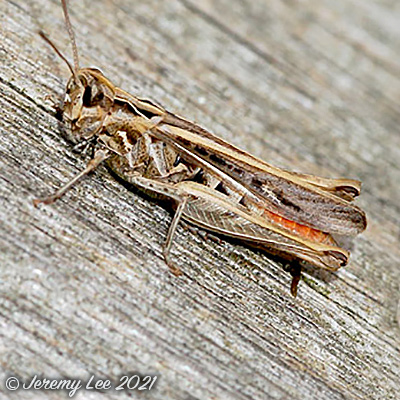
 |
|
Scientific Classifications explained » Amphibians » Ants » Aphids » Bees » Beetles » Birds » Bugs » Butterflies » Caterpillars » Damselflies » Dragonflies » Earwigs » Flies » Frog/Leafhoppers » Fungi » Galls » Grasshoppers » Harvestmen » Hoverflies » Lacewings » Ladybirds » Leaf Mines » Lichens » Mammals » Millipedes » Mosses » Moths » Sawflies » Slugs » Snails » Spiders » Trees & Shrubs » Wasps » Wild Flowers » Woodlice » Postboxes |
UK Nature > Grasshoppers > Chorthippus brunneus

Scientific Name: Chorthippus brunneus Common Name: Common Field Grasshopper Chorthippus brunneus, more commonly known as the common field grasshopper, is found throughout the UK, commonly in mostly dry and often sparse grassland, but also in gardens, from the beginning of summer until October. Measuring 15-25 mm in length, it is a brownish colour, but the colour varies; striped and mottled forms occur with parts of the body varying from buff through orange to purple. Very hairy below the thorax in both sexes. Diet is herbivorous, feeding mainly on grasses. Eggs are laid into the soil. Long season with nymphs hatching from late March. Adults appear from June and may survive until early December. A gregarious species, males can be seen displaying to females by rubbing their legs against their wings to create a 'song' - in this case, it is brief, single chirrup, repeated at short intervals. |
|

https://www.uknature.co.uk is a website dedicated to showing the immense diversity of UK nature and wildlife. Our vast range of habitats, from lowland arable to snow covered mountains, from storm-ravaged coastlines to peaceful inland freshwater lakes and rivers, from dry, sandy heaths to deciduous and coniferous forests, all these habitats contribute to the abundance of UK nature. We have wild birds in huge numbers either residing or visiting our shores (597 recorded species as at July 2013) and we must also not forget the humble back garden with its grass lawns, flower beds filled with nectar rich flowers, shrubs and trees, all designed to attract huge numbers of insects such as bees, moths, butterflies and hoverflies; and finally the small ponds which provide safe havens for frogs, toads, newts and even slow worms and grass snakes. www.uknature.co.uk is the showcase for my personal passion, photographing uknature in all its glory. I sincerely hope you all enjoy the fruits of my labours. This site and all images contained therein is © Jeremy Lee 2004 - 2025. All Rights Reserved. Site design by Jeremy Lee. Site development & IT Support by Stuart Lee. |